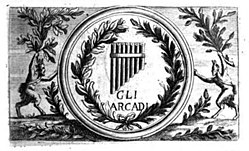Accademia dell'Arcadia

The Accademia dell'Arcadia , also Accademia degli Arcadi or Pontificia Accademia degli Arcadi (German Society of Arcadians ), was founded on October 5, 1690 in Rome by the poets' circle of Queen Christina of Sweden , who died the previous year .
The name of the academy refers to the bucolic poetry in prose and verse Arcadia (1501) by the Italian poet Jacopo Sannazaro as well as to the rural Greek region of the same name Arcadia in the center of the Peloponnese , which was the setting for the bucolic Greco-Roman poetry . Academy norms and customs were influenced by classical and rural mythology , including e.g. As the habit of academics , pseudonyms to use.
The academy quickly assumed a certain national character, and philosophers , writers and scientists of the Galilean school joined it to become part of it . Some composers have also been recorded, including a. Arcangelo Corelli , Bernardo Pasquini , and Alessandro Scarlatti .
All the poets had in common the desire to confront the artificiality of Marino's poetry and rather to propagate a return to classicism and, above all, to rationalism , which was derived from Cartesian philosophy (Descartes was already considered a pioneer of modernity at that time).
The ideals and guidelines to be followed for artistic works were simplicity, a sense of measure and beauty and an elegance that could, however, degenerate into a mannered gallantry.
Such ideas stemmed from the confrontation with contemporary French classical music , which at the time dominated the cultural panorama of Europe and saw itself as rational. In contrast to this, the Spanish and Italian literature were presented, which were accused of the "bad taste" of the Baroque .
It was the spirit of the nation's cultural defense that made the Italian intellectuals advocate the creation of the Accademia as a symbol of a new, national Italian culture. Accordingly, the academy also dominated the peninsula's poetic taste throughout the first half of the 18th century.
First of all, the extravagance and decadence of the Baroque were confronted in the form of “ anti-marinism ” of the 17th century. At the same time, they were looking for poetry that was simple and based on the naturalness of feeling.
Two different tendencies soon emerged within the academy: that of Gravina , which was modeled on Dante and Homer ; and the more moderate of the crescembini , who referred to Petrarch . The resulting dispute led Gravinas to leave the Accademia. He then founded the Accademia dei Quinti in 1711 .
This dispute was not only of a literary nature, for example, Gravina respected certain ethical values that were alien to Crescembini's hedonistic poetry.
The most important representative of the Accademia in the 18th century was Metastasio , who was famous throughout Europe for his libretti . With the spread of the Enlightenment and Romanticism, Arcadian poetry was judged rather negatively and accused of superficiality and indifference to the real world. The academy lost much of its vitality, but can claim the historic achievement of having developed pre-romantic and neoclassical poetry one after the other.
On January 4, 1788 was Goethe during his second stay in Rome, introduced by the Prince of Liechtenstein , with the shepherd name Megalio Melpomenio member of the Accademia. He reports about it in his Italian trip , giving the diploma he received.
In 1925 it took on the name "Accademia letteraria italiana". Since 1940 the academy has been housed in the Biblioteca Angelica .
literature
- Maria Teresa Acquaro Graziosi: L'Arcadia. Trecento anni di storia , Palombi, Roma 1991 (Quaderni dell'Ufficio Centrale per i Beni Librari e gli Istituti Culturali 4), ISBN 88-7621-113-6
Footnotes
- ^ Goethe: Italian journey. Second stay in Rome. Admission into the society of the Arcadians. zeno.org
- ↑ https://www. britica.com/topic/Academy-of-Arcadia
